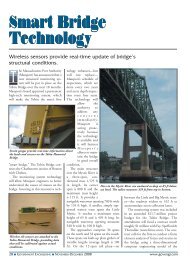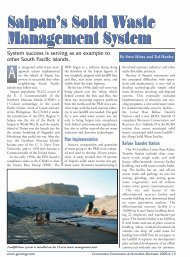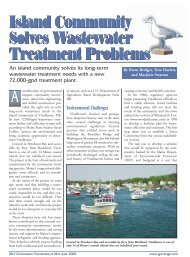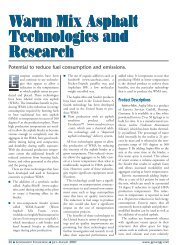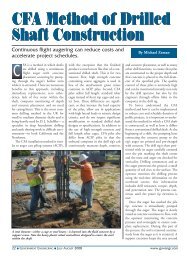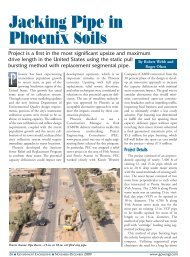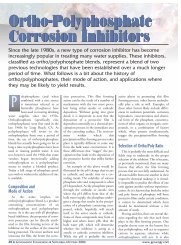Interstate 90 Sunset Interchange - Government Engineering Journal
Interstate 90 Sunset Interchange - Government Engineering Journal
Interstate 90 Sunset Interchange - Government Engineering Journal
You also want an ePaper? Increase the reach of your titles
YUMPU automatically turns print PDFs into web optimized ePapers that Google loves.
<strong>Interstate</strong> <strong>90</strong> <strong>Sunset</strong><br />
<strong>Interchange</strong>: Like<br />
Threading a Needle<br />
The new I-<strong>90</strong> <strong>Sunset</strong> <strong>Interchange</strong> project is a testament to<br />
innovative engineering, resiliency to challenges,<br />
and commitment to teamwork.<br />
By Karl Winterstein<br />
An aerial view of the $116.6-million <strong>Interstate</strong> <strong>90</strong> <strong>Sunset</strong><br />
<strong>Interchange</strong> project.<br />
W<br />
ith as little as 100 ft in which<br />
to work, building the<br />
$116.6-million <strong>Interstate</strong> <strong>90</strong><br />
<strong>Sunset</strong> <strong>Interchange</strong> project in<br />
Issaquah, WA, was like trying<br />
to thread a needle. The site for this X-<br />
shaped, 1.6-mile project was flanked by<br />
mountainous terrain, complex underground<br />
soils, glacial remains, underground<br />
water, and aquifers and boulders,<br />
some as big as small automobiles.<br />
In addition, Issaquah Creek, home to an<br />
endangered species of Chinook salmon,<br />
ran through the site.<br />
To thread this needle required a<br />
design that called for an elongated interchange<br />
with three levels to help it climb<br />
up the Sammamish Plateau, which is<br />
250 ft higher than the interchange.<br />
Threading this needle also required the<br />
use of tight roadway alignments for<br />
interchange operations.<br />
Included in the project, which took six<br />
years to complete, are four new bridges<br />
equipped with an innovative seismic isolation<br />
system, aesthetic enhancements,<br />
and habitat improvements. The four<br />
bridges span 3,200 ft. One in particular,<br />
the Crossing Bridge, is a 374-ft, threespan<br />
bridge that crosses I-<strong>90</strong> and the<br />
Issaquah Creek. Construction also added<br />
one lane to I-<strong>90</strong> along with a new undercrossing<br />
bridge<br />
with adjoining<br />
ramps, spanning<br />
the six lanes of I-<br />
<strong>90</strong>.<br />
Using Post-<br />
Tensioning<br />
To expedite<br />
construction<br />
while keeping I-<br />
<strong>90</strong> traffic flowing<br />
in both<br />
directions, the<br />
bridge was<br />
designed and<br />
constructed<br />
using 45 precast<br />
concrete U-<br />
shaped girder<br />
segments that<br />
were dropped<br />
into place and post-tensioned together.<br />
Building the bridge in this manner eliminated<br />
the use of temporary supports in<br />
the lanes of I-<strong>90</strong> and in the environmentally-sensitive<br />
Issaquah Creek.<br />
The second bridge, the Braid Bridge,<br />
is a 1,444-ft, eight-span, cast-in-place,<br />
post-tensioned concrete box girder<br />
bridge that carries the eastbound offramp<br />
over the eastbound on-ramp with<br />
a skew of nearly 70 degrees. Because of<br />
this skew, the columns at the fourth and<br />
fifth piers could not be located directly<br />
under the box girder. In lieu of outrigger<br />
bents to support the bridge’s 197-ft<br />
spans, eccentric bents were used. This<br />
eliminated the need to acquire additional<br />
rights-of-way while allowing for a<br />
greater contextual appearance.<br />
The remaining bridges are the<br />
Flyover Bridge and the Issaquah Creek<br />
Crossing, both of which were built<br />
using twin steel box girders. The Flyover<br />
Bridge is a four-span, 925-ft long, horizontally-curved<br />
bridge and the Issaquah<br />
Creek Crossing is a two-span, 492-ft<br />
long bridge. These bridges were<br />
designed and built using pipe and structural<br />
tubing with concentric connections<br />
to provide more efficient structural<br />
strength. This design and construction<br />
also enabled these bridges to have<br />
longer span lengths, tighter horizontal<br />
curves, and lower overall weights.<br />
Seismic Isolation<br />
All four of the project’s bridges use an<br />
innovative seismic isolation system on<br />
26 ■ GOVERNMENT ENGINEERING ■ SEPTEMBER–OCTOBER 2005 www.govengr.com
<strong>Interstate</strong> <strong>90</strong> construction required the use of tight roadway alignments<br />
for interchange operations.<br />
the curved structures. This system incorporates<br />
the use of a large isolation bearing<br />
between the bridge deck and the<br />
columns upon which they rest. The top<br />
of the bearing is connected to the<br />
underside of the bridge deck and the<br />
bottom is connected to the column. In<br />
the middle is a friction-reduced, bowlshaped<br />
plate to provide a flexible, movable<br />
surface. A special breakaway joint is<br />
used, which in the event of a major<br />
earthquake, allows the front position of<br />
the approach slab to break away, permitting<br />
the girders to move while providing<br />
additional seismic dampening.<br />
To meet the challenge of locating an<br />
interchange within the urban growth<br />
boundary, the design was made context<br />
sensitive to the physical surroundings.<br />
To achieve this, long sweeping bridge<br />
spans were used. This design also minimized<br />
the number of foundations adjacent<br />
to the creek. Habitat restoration,<br />
wetlands, and stream buffers, some of<br />
which were replaced and others restored,<br />
were constructed to maintain and preserve<br />
the wildlife and aquatic environment.<br />
Before the bridges could be built and<br />
the seismic isolation systems installed,<br />
the massive girders for these bridges had<br />
to be transported 180 miles to the project<br />
site. To accomplish this task, specially-designed<br />
tractor-trailer rigs had to be<br />
built for the transport, each over 200 ft<br />
long and with 86 wheels.<br />
Another construction challenge was<br />
underground<br />
boulders,<br />
identified during<br />
preliminary<br />
studies.<br />
D u r i n g<br />
drilling operations<br />
for the<br />
concrete foundations<br />
for the<br />
bridges, the<br />
contractor<br />
encountered<br />
boulders the<br />
size of small<br />
cars that were<br />
left behind<br />
from centuries-old<br />
glacial<br />
activity.<br />
Cutting through these boulders required<br />
drilling rigs equipped with oscillating<br />
drill heads capable of drilling down 80<br />
to 100 ft.<br />
Team Approach<br />
A team approach was used for both<br />
the monthly and weekly meetings to<br />
resolve issues. The monthly meetings<br />
addressed issues at the highest levels<br />
while weekly, and if required, impromptu<br />
project team meetings, were held to<br />
resolve site, design, and access issues as<br />
construction progressed. This proved of<br />
great benefit when it came to permitting.<br />
Due to multiple jurisdictional permit<br />
requirements, overlaps and conflicts<br />
had to be resolved. The solution was<br />
simple: each municipality<br />
or public agency facilitated<br />
resolutions for<br />
permits and timed them<br />
with the construction<br />
schedule.<br />
For a project of this<br />
size, coordination was<br />
critical between the various<br />
elements such as the<br />
complex structural<br />
designs, trail development,<br />
wetland mitigation,<br />
traffic engineering,<br />
and hydraulic engineering<br />
for stormwater<br />
ponds, stream restoration,<br />
endangered<br />
species, public involvement,<br />
and traffic maintenance.<br />
An outreach program was developed<br />
to keep neighborhoods and the local<br />
municipality informed of the issues<br />
and progress of the construction activity.<br />
This included night work and sudden<br />
changes in plans as a result of<br />
ongoing construction. To keep people<br />
informed, the outreach program used a<br />
monthly bulletin, a Web site, and a<br />
telephone hotline. It also included<br />
briefings by the Washington State<br />
Department of Transportation to city<br />
council members, the public, and<br />
media.<br />
The I-<strong>90</strong> <strong>Sunset</strong> <strong>Interchange</strong> project<br />
team also coordinated work efforts with<br />
a number of other related and impacted<br />
projects in the area, including the North<br />
Sammamish Plateau Access Road and<br />
the South Sammamish Plateau Access<br />
Road through the Issaquah Highlands,<br />
which form an approximately four-mile<br />
long new arterial network at the edge of<br />
the urban growth area.<br />
Fraught with complexities and unanticipated<br />
construction challenges, the<br />
project and area improvements were<br />
delivered on time and within budget<br />
constraints. The new interchange has<br />
alleviated traffic congestion locally and<br />
on I-<strong>90</strong> adjacent interchanges, has stimulated<br />
the local economy, and improved<br />
the overall quality of life in the region.<br />
And all of this was done by not so simply<br />
“threading a needle.”<br />
GE<br />
Mr. Winterstein, P.E., is a Principal Project<br />
Manager, Parsons Brinckerhoff, Seattle, WA.<br />
The Crossing Bridge was built using 45 precast concrete<br />
U-shaped girder segments that were dropped into<br />
place and post-tensioned together.<br />
www.govengr.com GOVERNMENT ENGINEERING ■ SEPTEMBER–OCTOBER 2005 ■ 27



